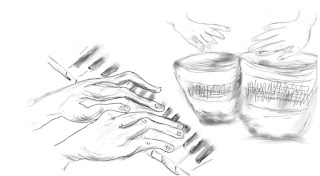Fieldwork observation 10th October, 2017 (observation 4, phase 2) revisits my fascination with anthropologist Tim Ingold's 'Parliament of lines'. I can see through my sketching, how I have become
perceptive to the children coming together, not just to to stroke Dave (usually in small groups of 3-4 children at a time) but to create lines of connectivity through the sociality of touch (Htu, 2014). Or as one child said, 'Dave's creation of pathways' of connection. This in turn enables a meshwork of movement and growth, temporal 'lines of becoming'. Rather like a rich tapestry, lines of cotton are made and joined together forming a picture or portraiture of the moment I am drawing, yet if we look closely at the process, turn the tapestry over, we see many loose threads, intricately woven that do not appear to fit together. Meshwork is then rather different from a network. Human and non-human relationships are tangled and enmeshed. The wonderful beauty of such communication can be its musicality and rhythm. The children rarely talk during these moments as they are not only sensually experiencing (Dave's silky fur lines and contours) but engaging active and passive intent as the same time. In observing and drawing this I too am telling their story - not with words - but through the use of my pencil becoming like a musical instrument that draws the line that "tells" (Causey, 2017). This is far greater in showing the transmission of affect, as drawing helps me understand and see the essence of experience in the encounter between Dave and the children,
perceiving it differently.
In order to consider movement, rhythm and meshwork, I need to enact it through my drawing, my own encounters with Dave, and giving him a belly rub are part of my participant-observation and how my seeing-drawing is from my own "body memory" too. In this I am entering a culture, through ways that fit the particular social identity, as it is within the social environment of the classroom. I am carefully perceiving and moving, acting and copying the children's everyday performances as a way to 'fit in'. This language of communication would be invisible as 'written word' and by making the invisible visible, deeper understanding of the social phenomenon can be shown.
Etude 4: Dave and the children creating lines and "pathways" of connectivity and musicality and rhythm of communication through movement and sensory experience:
 |
| Add caption |




